How can a brain injury affect my driving?

A brain injury (aka traumatic brain injury or TBI) occurs when a person sustains a serious blow or injury that affects and damages the brain. People can be affected differently after a brain injury, depending on the severity of the injury. Mild incidents may only have temporary repercussions where the person makes a full recovery, whereas more significant injury may cause bruising in the brain, bleeding, broken tissues or other physical deterioration to the brain. Serious injuries may result in permanent or long-term problems or in some cases, death.

More serious circumstances of brain injury may give rise to symptoms such as:
- Seizures or convulsions
- Severe and persistent headaches
- Ongoing nausea or vomiting
- Decreased or loss of consciousness for a significant amount of time (several minutes or hours)
- Coma conditions
- Weakness in extremities (usually fingers or toes)
- Decreased coordination
- Affected or slurred speech
- Confusion
- Bizarre behaviour or increased agitation
Any of the signs described above may affect a person’s general health and well-being, as well as their ability to complete regular, everyday tasks. Indeed, a brain injury is a medical condition that may impact on your driving capacity.
How do I know if I can drive after a brain injury?
Following any brain injury situation, it will be up to your treating doctor to determine if you are safe to resume or return to driving. Often, less severe injuries where the person exhibits mild symptoms for a brief time period will be medically cleared by the doctor to return to driving without requiring further testing or intervention. However, graver situations where the driver has sustained more serious or long-term repercussions from their injuries or has had substantial changes in their functioning, often alerts a Doctor to refer the person for an Occupational Therapy (OT) driving assessment. In NSW, it is actually the individual’s responsibility to disclose any medical condition or illness that potentially affects their driving to the RMS. However, many drivers are not familiar with these requirements and it often becomes the responsibility of their treating doctor to make this notification. Following your injury, your doctor will usually complete the RMS ‘Medical Fitness to Drive’ assessment form where he/she must indicate if you have medical clearance to drive. Often, doctors are unsure about whether a person is safe to drive after a brain injury, so they will recommend that they see a driver trained OT. The OT will complete an assessment that will essentially decide whether your brain injury is impacting on your driving ability.
What is an OT and how do they assess my driving?
An OT is a health professional who assists people to become more independent and improve their skills in all areas of life, such as driving. If you have a medical condition that could potentially decrease your ability to drive safely and to the required standards, an OT driving assessment is the process in NSW to determine fitness to drive.

Women driving car with hand on steering wheel looking at the road ahead.
The OT driving assessment is split into two parts:
1. Off-road test – The OT will first look at your vision, cognitive capacity and physical functioning to ascertain if there are any difficulties that might reduce your driving capability.
2. On-road test – You will then drive the driving instructor’s car for 1 hour. The driving instructor’s car is used for safety, as it is equipped with a dual-control brake. The OT observes your driving activity and will monitor how the brain injury may have affected your driving skills. As a general rule, as long as the driving instructor is not required to physically intervene (i.e. activate the dual-control brake or manoeuvre the steering wheel), you should pass the assessment. The driving instructor will not need to intervene unless you are in close danger of making contact with another vehicle, person or other object.
The entire assessment takes between 2-3 hours. The OT and driving instructor will let you know after the test how you’ve performed. The OT will decide what recommendations they will be making, which generally will be one of the following:
1. The brain injury is not affecting your driving ability and the OT will recommend that your licence is upheld (with any existing endorsements).
2. There are some areas of your driving that you will need to improve (e.g. if you made several driving errors during the assessment), and they may recommend a few lessons with a driving instructor to correct these issues. The OT may recommend an OT driving re-assessment after the completion of the recommended lessons.
3. The brain injury might have affected your physical capacity to control a vehicle and you require vehicle modifications to drive safely. In this case, you will have an endorsement on your licence that you can only drive with the specified modification. The OT will recommend a number of lessons with the driving instructor so you can become proficient in driving with the modification. Once you are assessed to be competent driving with the modification, you will need to attend the RMS disability test.
4.The brain injury is affecting your capacity to drive safely, and the OT does not think that further lessons, vehicle modifications or other strategies will benefit you. This is generally for situations where the brain injury has grossly affected someone’s cognitive capacity, where factors such as their decision-making, memory, spatial awareness and/or coordination may be impaired. In this instance, the OT will need to make the recommendation to cancel your licence.
What happens after the assessment and I know the outcome?
After the OT has discussed the result of the assessment with you, he/she will complete the report that is sent to the RMS, your doctor and any other relevant party (e.g. employer, other health professional). The RMS will then proceed with the recommendations on the report.



